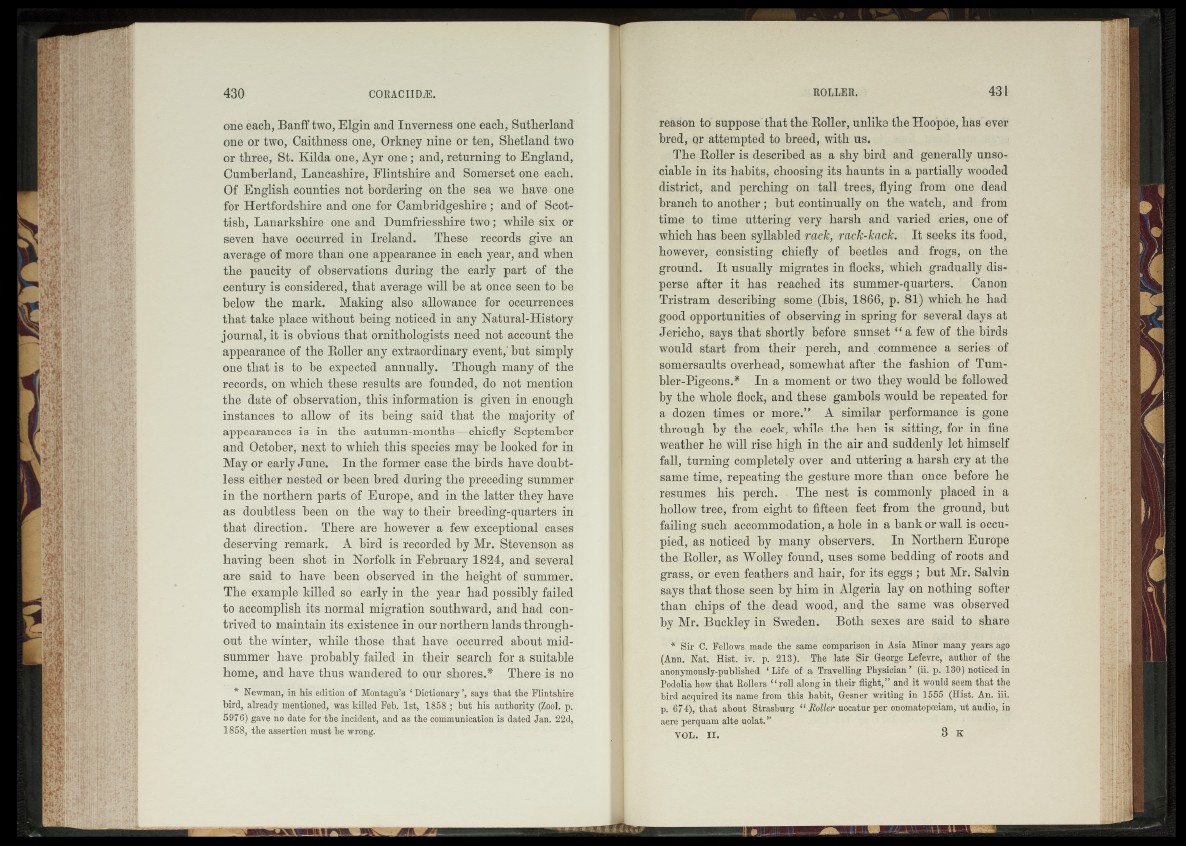
one each, Banff two, Elgin and Inverness one each, Sutherland
one or two, Caithness one, Orkney nine or ten, Shetland two
or three, St. Kilda one, Ayr one; and, returning to England,
Cumberland, Lancashire, Flintshire and Somerset one each.
Of English counties not bordering on the sea we have one
for Hertfordshire and one for Cambridgeshire ; and of Scottish,
Lanarkshire one and Dumfriesshire two; while six or
seven have occurred in Ireland. These records give an
average of more than one appearance in each year, and when
the paucity of observations during the early part of the
century is considered, that average will be at once seen to be
below the mark. Making also allowance for occurrences
that take place without being noticed in any Natural-History
journal, it is obvious that ornithologists need not account the
appearance of the Roller any extraordinary event,’ but simply
one that is to be expected annually. Though many of the
records, on which these results are founded, do not mention
the date of observation, this information is given in enough
instances to allow of its being said that the majority of
appearances is in the autumn-months—chiefly September
and October, next to which this species may be looked for in
May or early June. In the former case the birds have doubtless
either nested or been bred during the preceding summer
in the northern parts of Europe, and in the latter they have
as doubtless been on the way to their breeding-quarters in
that direction. There are however a few exceptional cases
deserving remark. A bird is recorded by Mr. Stevenson as
having been shot in Norfolk in February 1824, and several
are said to have been observed in the height of summer.
The example killed so early in the year had possibly failed
to accomplish its normal migration southward, and had contrived
to maintain its existence in our northern lands throughout
the winter, while those that have occurred about midsummer
have probably failed in their search for a suitable
home, and have thus wandered to our shores.* There is no
* Newman, in his edition of Montagu’s ‘ Dictionary says that the Flintshire
bird, already mentioned, was killed Feb. 1st, 1858 ; but his authority (Zool. p.
5976) gave no date for the incident, and as the communication is dated Jan. 22d,
1858, the assertion must be wrong.
reason to suppose that the Roller, unlike the Hoopoe, has ever
bred, or attempted to breed, with us.
The Roller is described as a shy bird and generally unsociable
in its habits, choosing its haunts in a partially wooded
district, and perching on tall trees, flying from one dead
branch to another ; but continually on the watch, and from
time to time uttering very harsh and varied cries, one of
which has been syllabled rack, rack-kack. It seeks its food,
however, consisting chiefly of beetles and frogs, on the.
ground. It usually migrates in flocks, which gradually disperse
after it has reached its summer-quarters. Canon
Tristram describing some. (Ibis, 1866, p. 81) which he had
good opportunities of observing in spring for several days at
Jericho, says that shortly before sunset “ a few of the birds
would start from their perch, and commence a series of
somersaults overhead, somewhat after the fashion of Tumbler
Pigeons.* In a moment or two they would be followed
by the whole flock, and these gambols would be repeated for
a dozen times or more.” A similar performance is gone
through by the cock, while the hen is sitting, for in fine
weather he will rise high in the air and suddenly let himself
fall, turning completely over and uttering a harsh cry at the
same time, repeating the gesture more than once before he
resumes his perch. The nest is commonly placed in a
hollow tree, from eight to fifteen feet from the ground, but
failing such accommodation, a hole in a bank or wall is occupied,
as noticed by many observers. In Northern Europe
the Roller, as Wolley found, uses some bedding of roots and
grass, or even feathers and hair, for its eggs; but Mr. Salvin
says that those seen by him in Algeria lay on nothing softer
than chips of the dead wood, and the same was observed
by Mr. Buckley in Sweden. Both sexes are said to share
* Sir C. Fellows made the same comparison in Asia Minor many years ago
(Ann. Nat. Hist. iv. p. 213). The late Sir George Lefevre, author of the
anonymously-published ‘ Life of a Travelling Physician ’ (ii. p. 130) noticed in
Podolia how that Rollers “ roll along in their flight,” and it would seem that the
bird acquired its name from this habit, Gesner writing in 1555 (Hist. An. iii.
p. 674), that about Strasburg “ Roller uocatur per onomatopceiam, ut audio, in
aere perquam alte uolat.”
VOL. I I. 3 K